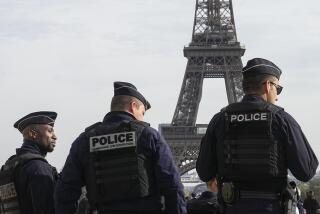Marathoners’ Deaths Stun Friends
Friends and co-workers said Monday they were stunned by the deaths of two Los Angeles Marathon runners, the first fatalities in 16 years in the annual race that draws more than 20,000 participants and whose only qualification is a desire to participate.
Retired Sheriff’s Deputy James Leone, 60, who may have suffered from cardiovascular disease, collapsed three miles into Sunday’s 26-mile race, and Los Angeles Police Det. Raul Reyna, 53, whom friends described as being in good physical condition, had a heart attack two miles from the finish line, officials said. The exact cause of death for both men is still pending.
“For everybody here, [Leone’s] death comes as a shock,” said Sheriff’s Lt. Tim Murakami, who worked at the department’s city of Industry station with the former deputy. “When a guy does his time and retires -- he paid his dues in the line of fire -- you wish him a long life. It’s sad when that’s kind of cut short.”
Capt. Jim Voge, Reyna’s commanding officer, said he rushed to Good Samaritan Hospital after receiving a call about his colleague but arrived too late. Police Chief William J. Bratton was there along with Reyna’s family, he said.
Voge said Reyna, who investigated officer-involved shootings, had recently lost a few pounds and talked about how he was preparing for the marathon.
“He was always in good shape and I wanted to know what his secret was,” Voge said. “This was not something he undertook haphazardly.”
The only other known death during the Los Angeles Marathon came in 1990, when a 59-year-old Altadena man under a doctor’s care for hypertension suffered a heart attack.
Unlike the elite Boston Marathon, where entrants must qualify by time in a previous marathon, Los Angeles, like New York, has no requirements to prove readiness. Entrants can register to participate up to the day before the race, and typically 4,000 to 5,000 jump in at the last moment.
Experts said the deaths of the two officers are a reminder of the basic precautions one should take, particularly those over 35, before engaging in long-distance running or other strenuous workouts. For example, participants should be aware of their family’s health history, especially if there is evidence of heart disease, and should have seen a doctor recently, they said.
“When you look at the age of the victim, if they’re over 35, the underlying heart disease is almost always hardening of the arteries,” said Dr. Steven Van Camp, the head of UCI Medical Center’s sports cardiology program. “We know that’s the culprit in 90-plus-percent of the victims who died when they’re running.”
Studies have found that the risk of dying while running is low -- an estimated one sudden death per 1.5 million episodes of physical activity.
And only one in 20 heart attacks is associated with exertion, according to a 2003 article published by Dr. Benjamin Ebert, a physician and scientist at Brigham and Women’s Hospital in Boston.
The risk of a heart attack or cardiac arrest while exercising is highest in people with an existing heart condition.
The most famous case of “sudden death during exercise,” as the phenomenon is known, is that of running guru Jim Fixx, who died during his regular 10-mile trek at age 52, in 1984. An autopsy showed he had severe coronary artery disease. He also had hereditary predisposition; his father died at an early age of heart disease.
Other primary known risk factors for cardiovascular disease include older age, high blood pressure, diabetes, elevated cholesterol levels and a history of smoking.
Running itself, Van Camp said, is not necessarily to blame.
“In general, exercise is beneficial for people, and it has been shown to decrease heart disease risks,” he said. “But during vigorous exercise there is an increase in risk.... The things that raise my attention are excessive shortness of breath with exercise, chest discomfort with exercise, lightheadedness.”
Dr. Rudra Sabaratnam, medical commissioner for the Los Angeles Marathon, said deaths of any runners during a marathon were “a fairly rare occurrence.”
He said the Los Angeles event has several medical stations along the course, manned by physicians, nurses and other volunteers. The Los Angeles Fire Department also has paramedics on standby around the course.
But Sabaratnam urged caution to participants, especially those in high-risk categories.
“If somebody has heart disease, obviously they would have to get some kind of clearance from a doctor,” he said. Additionally, he said, if you are “overweight, have high blood pressure or are diabetic, you’re more likely to have heart disease, so you’re well-advised to get yourself checked out.”
Some longtime friends of Leone said they did not know he was a runner.
“You would not know Jim was physically fit by looking at him,” said Sheriff’s Lt. Murakami. “I’ve known him for 13 years. I didn’t know he ran the extent that he did. I had no idea.”
Chatsworth resident David Lawson, 61, a trained emergency medical technician who was behind Leone when he collapsed, performed CPR until help arrived.
“I feel so bad for his family,” he said. “I kept waiting for his eyes to blink, for him to show some sign of life.”
Police Capt. Voge said law enforcement officers are accustomed to death, but that doesn’t lessen the shock and grief at losing one of their own. Reyna, Voge said, was a rare mix: a good mentor, a skilled detective, a patient man who never spoke ill of others.
“For the most part, the people here will mourn like the family will,” Voge said. “We’re his police family.”
More to Read
Sign up for Essential California
The most important California stories and recommendations in your inbox every morning.
You may occasionally receive promotional content from the Los Angeles Times.










